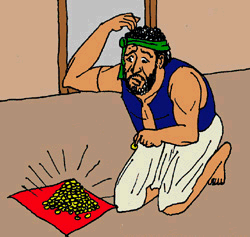
Jai Jagannath Mahaprabhu – The Lord of the Universe
This is a narration about Lord Jagannath’s Ratha Yatra , its significance and its relation to the Journey of Life
On this day the Lord of the Universe – Lord Jagannath himself comes out of his palace among all his followers to a journey …… a journey of life …. i.e. a journey from his working place (Karma Bhumi) to his birth place (Janma Bhumi) and then back. The Lord himself takes the journey along with his elder brother Lord Balabadhra and his Sister Devi Subadhra along with thousands and thousands of his followers and devotees .
This journey of life by Lord Jagannath has a meaning and significance. This journey by the lord is taken on wooden chariots called ‘Rath’. All the three deities have their own individual chariots . Lord Balabadhra chariot is called Taladwadja, Devi Subdhra’s chariot is called Tarpadalana and Lord Jagannath’s chariot is called Nandighosh.
The Story of Rath Yatra: Why Hindus celebrate Lord Jagannath Festival?
Once upon a time while Lord Jagannath was away, His dearest devotees shed tears in His absence. When Lord Jagannath heard these accounts of immense love in separation, His eyes opened wide and filled with tears, His hair began to stand on end, and His arms and legs shrank as He went into the state of pure spiritual bliss.
Seeing Lord Jagannath in this condition, Balabhadra (his elder brother) and Subhadra (his younger sister) both displayed similar features and went into the state of spiritual bliss. Thus today the deities of Lord Jagannath, Subhadra, and Balabhadra represent this time on Jagannath Rath Yatra.
The festival of Rath Yatra represents Lord Jagannath’s yearning to rejoin with His devotees in Gundicha Temple (which was his birthplace – Janama Bhumi) and Mausi Maa Temple (which was his aunt’s home).

As per Hindu tradition, the Lord gets lovesick once a year during the month of Ashadha. To make the Lord happy – the devotees take Him, His elder brother, and younger sister – out of the Jagannath Temple on a lavish procession in a chariot to get together with His devotees in Gundicha Temple which is located 2 miles away to the North. The deities stay there for complete seven days, followed by a visit to their aunt’s home (Mausi Maa Temple) on their return journey back to Jagannath Temple.

Five hundred years ago, Lord Chaitanya Mahaprabhu, the incarnation of Lord Krishna, requested His devotees to observe Ratha Yatra with great delight and enthusiasm. On this day, Lord Chaitanya used to go down on his knees and scrub the Gundicha sanctuary where Lord Jagannath would stay.

Ratha Yatra is a Hindu festival associated with Lord Jagannath held at Puri in the state of Odisha, India. It is the oldest Ratha Yatra taking place in India and the World, whose descriptions can be found in Brahma Purana, Padma Purana, and Skanda Purana and Kapila Samhita.
Description
Ratha Jatra, the Festival of Chariot: Chariots of Shri Jagannath is celebrated every year at Puri, the temple town in Odisha, on the second (dwitiya) day of shukla pakhya (waxing cycle of moon) of Ashadha Maasa (3rd month in Lunar Calendar). The presiding deities of the Jagannath Temple, Puri’s main temple, Lord Jagannath, Lord Balabhadra and Goddess Subhadra, with the celestial wheel (Sudarshana Chakra/ସୁଦର୍ଶନ ଚକ୍ର ) are removed from the temple in a ceremonial procession to their chariots. The huge, colorfully decorated chariots are drawn by multitude of devotees on the bada danda, the grand avenue to the Gundicha Temple (Gundicha – King Indradyumna’s Queen), two miles away to the North. On the way the chariot of Lord Jagannatha, Nandighosa (ନନ୍ଦିଘୋଷ) waits near the crematorium of Bhakta Salabega (ଭକ୍ତ ସାଲବେଗ) a Muslim devout to pay him tribute.

On their way back from the Gundicha Temple, the three deities stop for a while near the Mausi Maa Temple (Aunt’s abode) and have an offering of the Poda Pitha, which is a special type of pancake supposed to be the Lord’s favorite. After a stay for seven days, the deities return to their abode. The return journey of Puri Jagannath Ratha Jatra is known as Bahuda Jatra.
This is the only time of the year when devotees who are not allowed in the temple premises, such as non-Hindus and foreigners, can get their glimpse of the deities. During the festival, devotees from all over the world go to Puri with an earnest desire to help pulling the Lords’ chariots with the help of other priests pulling the chariots with ropes. They consider this auspicious deed. The huge processions accompanying the chariots play devotional songs with drums, tambourines, trumpets etc. Children line the streets through which the chariot will pass and add to the mass chorus.
The Ratha carts themselves are approximately 45 feet (14 m) high and are pulled by the thousands of pilgrims who turn up for the event; the chariots are built anew each year only from a particular type of tree. Millions of devotees congregate at Puri for this annual event from all over the country and abroad.
Chandana Jatra(ଚନ୍ଦନ ଯାତ୍ରା)

The construction of the chariots starts on Akshaya Trutiya, the third day of the bright fortnight of Vaisakha, with ritual fire worship. This takes place in front of the palace of the King of Puri and opposite the main office of the Puri temple. On this day, the new agricultural season starts and farmers start plowing their fields. This day also marks the beginning of the summer festival of the deities, also known as the sandalwood festival or Chandan Yatra, which lasts for three weeks.
In this festival, the representative images of the presiding deities are taken out in colorful processions and given a ceremonial boat ride in the Narendra pokhari/tank (ନରେନ୍ଦ୍ର ପୋଖରୀ) every day. In an interesting demonstration of the assimilative character of the Jagannatha cult, Madanmohana (ମଦନମୋହନ) and Rama Krushna, representing Jagannatha & Balarama partake in the festival with the representatives’ images of the presiding deities of five main Shiva temples of Puri. These are curiously known as Pancha Pandava (ପାଞ୍ଚ ପାଣ୍ଡବ), the five brothers of the Mahabharata story. Later the deities have a ritual bath in a small temple in the middle of the tank, in stone tubs filled with water, sandalwood paste, scents, and flowers.

This sandalwood festival culminates in the Snana Yatra (ସ୍ନାନ ଯାତ୍ରା ), the Bathing Festival on the full moon day of the month of Jestha. On this day, the presiding deities descend from their seats on an elevated platform in the sanctum sanctorum, the bejeweled throne. They are bathed in 108 pots of water brought from the suna kua, the golden well and assume the elephant form on the special bathing platform, close to the Eastern boundary wall of the temple.
From that day the deities remain in symbolic and ritual convalescence for about two weeks. They are barred from the view of the ordinary devotees. Only three special patta chitras, traditional Oriya paintings of natural colors on cloth stiffened with starch, known as Anasara Pattis, are strung on a bamboo screen hiding the deities from public view, can be seen by the public. During this period, the deities are given only roots, leaves, berries and fruits to cure them of their indisposition. This ritual is a reminder of the strong tribal elements in the genesis and evolution of the Jagannatha cult. The progeny of Lalita, daughter of the original tribal worshipper Biswabasu, chieftain of hunters, and the Brahmin priest Vidyapati, are known as daitapatis or daitas. They have the almost exclusive privilege of serving the Lord during the convalescence and through the entire period of Ratha Jatra or the Festival of Chariots.

The most significant ritual associated with the Ratha-Yatra is the chhera pahara. During the festival, the Gajapati King wears the outfit of a sweeper and sweeps all around the deities and chariots in the Chera Pahara (sweeping with water) ritual. The Gajapati King cleanses the road before the chariots with a gold-handled broom and sprinkles sandalwood water and powder with utmost devotion. As per the custom, although the Gajapati King has been considered the most exalted person in the Kalingan kingdom, he still renders the menial service to Jagannath. This ritual signified that under the lordship of Jagannath, there is no distinction between the powerful sovereign Gajapati King and the most humble devotee.

Chera pahara is held on two days, on the first day of the Ratha Yatra, when the deities are taken to garden house at Mausi Maa Temple and again on the last day of the festival, when the deities are ceremoniously brought back to the Shri Mandir.
As per another ritual, when the deities are taken out from the Shri Mandir to the Chariots in Pahandi Vijay.

The Chariots
The three chariots of Balabhadra, Subhadra and Jagannatha are newly constructed every year with wood of specified trees like phassi, dhausa, etc. They are customarily brought from the ex-princely state of Dasapalla by a specialist team of carpenters who have hereditary rights and privileges for the same. The logs are traditionally set afloat as rafts in the river Mahanadi. These are collected near Puri and then transported by road.

The three chariots are decorated as per the unique scheme prescribed and followed for centuries stand on the Bada Danda, the Grand Avenue. Covered with bright canopies made of stripes of red cloth and combined with those of black, yellow and green colours, the huge chariots are lined across the wide avenue in front of the majestic temple close to its eastern entrance, which is also known as the Sinhadwara or the Lion’s Gate.

Around each of the chariots are nine Parsva devatas, painted wooden images representing different deities on the chariots’ sides. Each of the chariots is attached to four horses. These are of different colours – dark ones for Balarama, white ones for Jagannatha, and red ones for Subhadra. Each chariot has a charioteer called Sarathi. The three charioteers attached to the chariots of Jagannatha, Balarama and Subhadra respectively are Daruka, Matali and Arjuna.
Taladhwaja (ତାଳଧ୍ୱଜ)
The Chariot of Balabhadra named as Taladhwaja or Langaladhwaja. The Lord is accompanied by Ramakrishna.

The chariot of Lord Balarama, called the Taladhwaja, is the one with the Palm Tree on its flag. It has fourteen wheels, each of seven-foot diameter and is covered with red and green cloth. Its height is forty-four feet.
Taladhwadja –
Tala – means rhythm, pace, beat. Dhwadja – signifies the propaganda
Taladhwadja – to propagate life in a rhythmic manner.
Darpadalana(ଦର୍ପଦଳନ )
The chariot of Subhadra named as Darpadalana or Devadalana or Padmadhwaja(ପଦ୍ମଧ୍ଵଜ). The Goddess is accompanied by Sudarshana(ସୁଦର୍ଶନ). (ମନୋଜ)

The chariot of Subhadra, known as Dwarpadalana, literally “trampler of pride,” is forty-three feet high with twelve wheels, each of seven-foot diameter. This chariot is decked with a covering of red and black cloth – black being traditionally associated with Shakti and the Mother Goddess.
Darpadalana – Dapra Means Ego/pride, Dalana means to diminish/trample
Darpadalana means to root out/crush all evil in our lifes— kama, krodha, moha, lobha, mada , marchyja i.e lust, anger, selfishness, greed, arrogance and ego/pride.
Nandighosha (ନନ୍ଦିଘୋଷ)
The chariot of Lord Jagannath is named as Nandighosha or Garudadhwaja or Kapiladhwaja. The Lord is accompanied by Madanmohan.

Lord Jagannatha’s chariot is called Nandighosa. It is forty-five feet high and forty-five feet square at the wheel level. It has sixteen wheels, each of seven-foot diameter, and is decked with a cover made of red and yellow cloth. Lord Jagannatha is identified with Krushna, who is also known as Pitambara, the one attired in golden yellow robes and hence the distinguishing yellow stripes on the canopy of this chariot.
Nandighosh – the journey of life to become blissful and happy – life full of Ananda and happiness .
Significance
The lord tells us by taking this Yatra that to first adapt and propagate our lifestyle in a rhythm (Tala) that is to be followed daily i.e. wake , eat, work, sleep, exercise, etc at the particular time every day. Every day should have the same rhythm. Once life propagates in a rhythmic manner we should trample and crush all the evil qualities within us (dapradalana) which will make our life’s journey blissful and anandmaya (nandighosha). The journey is taken on the Bada danda or which signifies the span of life and the life of evolution as lord travels to his birthpace i.e. life toggles from our birth to death.
The yatra is for 9 days which also signifies the Navdwars of our body that is 2 eyes, 2 ears, 2 nosestrills, 1 mouth, maladwara and mutradwara.
Suna Besha(ସୁନା ବେଶ)

The Suna Besha of Lord Jagannath
After the chariots of the deities return to the main temple from the Gundicha temple, the deities are attired in gold ornaments and worshiped on the chariots. This celebration is known as Suna Besha. Tradition maintains that this event was first started by King Kapilendra Deb in 1460, when after returning victorious from war he donated gold to Lord Jagannath. The deities are adorned with gold jewelry weighing nearly 208 kg.
The Meaning of Terms
Jagannath: Lord Jagannath is a reincarnation of lords Vishnu and Krishna. It is the name of the deity worshiped in Hinduism and Buddhism. The term is a compound word, consisting of “Jagan” meaning Lord and “Nath” meaning universe. It literally means “Lord of the Universe”.
Rath: It is a Sanskrit word, meaning chariot or carriage.
Yatra: It is a Sanskrit word, meaning journey or pilgrimage.
Source: Wikipedia
Narrations By: Sri Yogananda
Jagannath Swami Nayan-Path-Gami Bhavatu Me ||
From Poem Sri Jagannath Astakam by Sri Adi Sankaracharya
Jay Jagannath Mahaprabhu
























